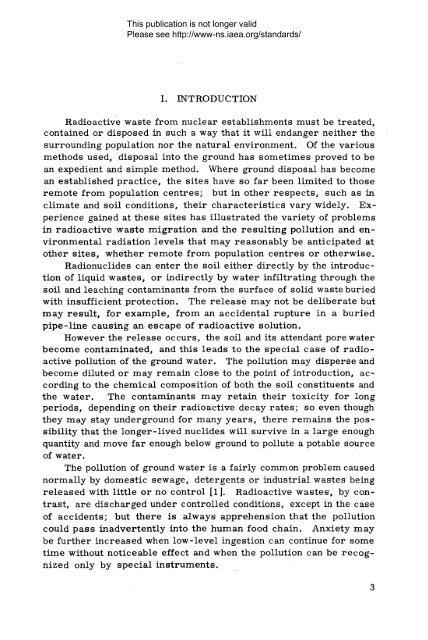Safety_Series_015_1965 - gnssn - International Atomic Energy ...
Safety_Series_015_1965 - gnssn - International Atomic Energy ...
Safety_Series_015_1965 - gnssn - International Atomic Energy ...
You also want an ePaper? Increase the reach of your titles
YUMPU automatically turns print PDFs into web optimized ePapers that Google loves.
This publication is not longer validPlease see http://www-ns.iaea.org/standards/I. INTRODUCTIONRadioactive waste from nuclear establishments must be treated,contained or disposed in such a way that it will endanger neither thesurrounding population nor the natural environment. Of the variousmethods used, disposal into the ground has sometimes proved to bean expedient and simple method. Where ground disposal has becomean established practice, the sites have so far been limited to thoseremote from population centres; but in other respects, such as inclimate and soil conditions, their characteristics vary widely. Experiencegained at these sites has illustrated the variety of problemsin radioactive waste migration and the resulting pollution and environmentalradiation levels that may reasonably be anticipated atother sites, whether remote from population centres or otherwise.Radionuclides can enter the soil either directly by the introductionof liquid wastes, or indirectly by water infiltrating through thesoil and leaching contaminants from the surface of solid waste buriedwith insufficient protection. The release may not be deliberate butmay result, for example, from an accidental rupture in a buriedpipe-line causing an escape of radioactive solution.However the release occurs, the soil and its attendant pore waterbecome contaminated, and this leads to the special case of radioactivepollution of the ground water. The pollution may disperse andbecome diluted or may remain close to the point of introduction, accordingto the chemical composition of both the soil constituents andthe water. The contaminants may retain their toxicity for longperiods, depending on their radioactive decay rates; so even thoughthey may stay underground for many years, there remains the possibilitythat the longer-lived nuclides will survive in a large enoughquantity and move far enough below ground to pollute a potable sourceof water.The pollution of ground water is a fairly common problem causednormally by domestic sewage, detergents or industrial wastes beingreleased with little or no control [1]. Radioactive wastes, by contrast,are discharged under controlled conditions, except in the caseof accidents; but there is always apprehension that the pollutioncould pass inadvertently into the human food chain. Anxiety maybe further increased when low-level ingestion can continue for sometime without noticeable effect and when the pollution can be recognizedonly by special instruments.3
















